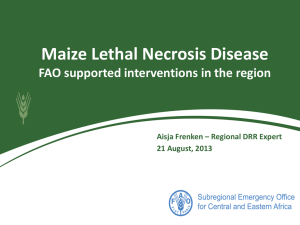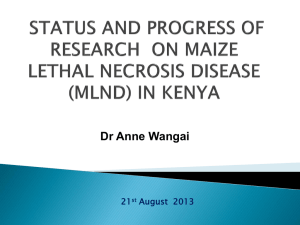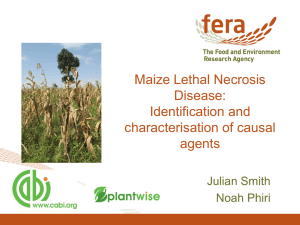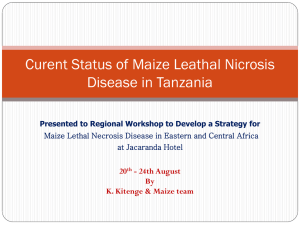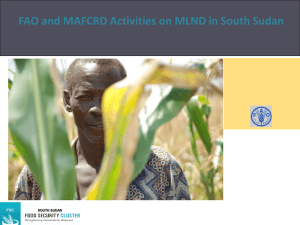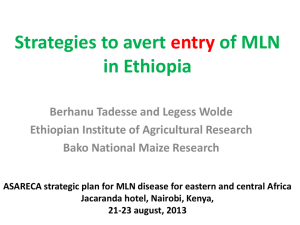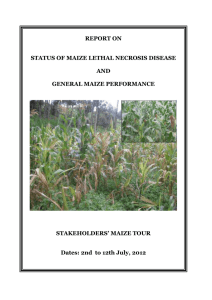1.Emerging pests_FAORAF_Joyce full version
advertisement
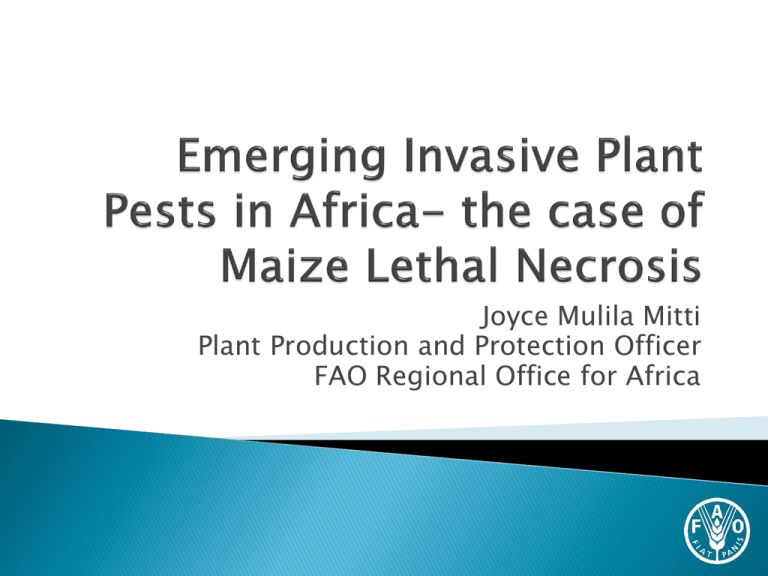
Joyce Mulila Mitti Plant Production and Protection Officer FAO Regional Office for Africa Background ◦ Thoughts on invasive plant pests ◦ Drivers of spread of invasive pests MNLD History and current knowledge Disease manifestation MLND interventions in Kenya Management Options Recognition of the significant losses to farmers and food security of plant pests and diseases. Many are endemic, with periodic upsurges or outbreaks under favourable conditions. Of significant economic, trade and/or food security importance for a considerable number of countries i. ii. iii. iv. v. Environmental factors: weather, climate, wind borne Pest/disease threats- vector-borne (pathogens) Production Practices Biological events (Long distance) movement Locusts Fungal diseases (wheat, potato...) Climate - changes: ◦ cropping range => changing pest ranges => changing predator populations ◦ pest population dynamics ◦ susceptibility to disease (vector distribution, plant susceptibility...) Overlapping planting seasons Expanded areas under a single crop Perennial culture (e.g. banana) Presence of alternate wild hosts Abiotic stresses Inappropriate use of insecticide Overuse of inputs such as herbicide • MLND – Emerging New Disease of Maize in East Africa • Leaf yellowing, scorching, necrosis and eventual death of the affected plant. • Affected plants decline rapidly (within days to weeks). • Reports suggested rapid spread within and between the fields. Source: CIMMYT “Maize farmers in Kericho and Bomet suffer a loss due to outbreak of a fungal disease” “Despair as mysterious bug destroys maize farms” “Disease threatens Kenya’s maize crop” “The maize disease that could change Kenya” “Kenya: 300 Hectares of maize ruined by disease in Nandi” “Experts at war as maize growers harvest big losses” “Kenyan maize crop failing….and Ministry of Agric failings” MLND is known officially in Kenya since 2011. In Tanzania it was reported in late 2012 in Arusha, Mwanza and Manyara In Uganda MLND is reported in Busia and Tororo districts Unconfirmed reports of occurrence in Rwanda First reported in Bomet district in South Rift Valley during the Short rains of 2011 Initial hotspots appeared in places where mono-crop maize was grown continuously Current status of spread ◦ ◦ ◦ ◦ ◦ 30 districts in Rift Valley, 5 districts in Eastern Kenya, 9 districts in Central Kenya, 5 districts in Western Kenya 6 districts in Nyanza Over 77,000 ha of maize were affected in 2012, translating into an estimated loss of 1.4 million bags each of 90 kgs worth about Ksh 4.4 billion (USD 52 Million). Incidence of MLND* District 90,000 hectares MLND affected districts Kisii Narok Bomet Ngakinyua Nakuru Embu Meru Eldoret Makueni Machakos Bungoma Kakamega Incidence (%) 90 90 80 80 70 60 60 5 – 100 – 100 – 100 – 100 – 100 – 100 – 100 – 20 Nil Nil Nil Nil •MLND spread in 90,000 ha [4.3% of 2.13 million ha devoted to maize in Kenya] *Source: Report on MLND, Multidisciplinary Team Report, Ministry of Agric, Kenya (July 2012) Causal agents: Maize chlorotic mottle(MCMV) & sugarcane mosaic viruses (SCMV) Cause of disease emergence: not known, SCMV known to occur in Kenya and many other countries in Africa; MCMV is new. The extent of spread is evidence that the disease has been present for sometime (such infection unlikely in 1 to 2 seasons). Vector control and resistant varieties ◦ No resistance to MLND ◦ But resistance to SCMV or MCMV prevents MNLD Sugarcane mosaic virus Potyvirus Potyvirus (source: ICRISAT) Aphids Source:INERA Source: CIMMYT Maize chlorotic mottle virus Tombusvirus Tombusvirus (Source L. Kumar) Thrips RA Naidu Source: University of Hawaii Maize lethal necrosis disease (MLND) Sum of all RA Naidu Potyvirus (source: ICRISAT) ©Edwin Cheserek Source: CIMMYT Source: University of Hawaii Leaf yellowing, scorching, necrosis and eventual death of the affected plant. Affected plants decline rapidly (within days to weeks) Reports suggest rapid spread within and between fields. Symptoms appear at different stages of plant growth; no uniform pattern of disease development suggesting external factor in transmission; e.g. insect vector transmission. Debates on the causes: fungal disease, poor seeds, varietal, agronomic practices etc; whether to burn damaged crop and whether to feed to animals MLND Task Force formed- KARI, MOA, PPSD, KEPHIS, ICIPE, FAO, KAPAP Resource Mobilization: proposal developed for comprehensive management of MLND submitted to the World Bank On-going research: extensive varietal screening of germplasm of over 2000 materials in 4 locations including Niavasha and Bomet. ◦ Screening done both under natural and artificial situations (use of inoculum) ◦ Few lines showing tolerance- need for further testing in multi-locations Screening of different pesticides for control of vectors; 19 pesticide formulations being evaluated at Naivasha and Bomet on 1 variety by PCPB ◦ Seed dressing with fungicide in addition to spraying, the crop fairs better ◦ Spraying without seed dressing; crop performs poorly ◦ All pesticides effective at killing thrips, but new thrips populations develop fast requiring several sprays ◦ Thrips hide in leaf funnels so difficult to completely kill Training of staff from KARI and KEPHIS on seed testing; capacity to determine whether disease is seed borne. Regional workshop convened by KARI/CIMMYT ◦ Confirmed Regional presence of disease; ◦ Concern at low level of resistance ◦ Recommended establishment of a centralized regional screening facility in Kenya for Central, Eastern and Southern Africa ◦ Agreed on urgent need to address genetic architecture of MLND, seed transmission, alternative hosts, host-vector interactions and management ◦ Need to initiative seed production and delivery mechanisms for the disease tolerant lines ◦ Support for continuous MLND surveillance ◦ Socio-economic studies on impact of the disease ◦ Awareness creation to involve and target farmers proactively ◦ Agreement that disease control should be regional; KARI and CIMMYT to develop a C/N. Awareness creation: FAO has provided support to the MOA to develop a manual for TOT on MLND. ◦ Brochures and posters, radio programmes on MLND also developed. Phytosanitiation (elimination of infected plants) – feasible if disease is detected early, however, large scale implementation is difficult Crop rotation – break in cropping cycle can reduce the disease persistence and spread Vector control – pesticides to control insects can be effective both as mitigation and pre-emptive option. However, expensive and not eco-friendly. Host resistance – Some few MLND resistant sources have been identified, can offer best protection against the diseases Thank you all for your attention!
